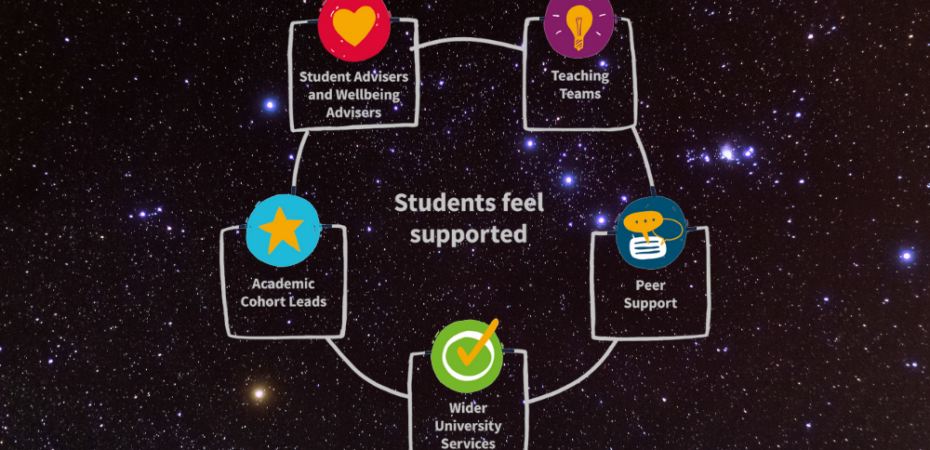
In this extra post, Andrew McDiarmid highlights the new Student Support Model↗️ at the University, and explains how this constellation of care supports and guides our students and teaching teams to face complex challenges. Andrew is an Academic Design Lead on the Student Support Project Team.
The Student Support Model at The University of Edinburgh represents a wholesale restructuring of how students are supported. Its implementation is complex, requiring a number of new roles and policies. At its core, however, the model’s aim is simple: consistency. All taught students will have a named Student Adviser, and will be provided access to staff dedicated to, and skilled in, enhanced course and programme advice and guidance, wellbeing and mental health, and professional, academic and study skills development. These teams are connected to the central support services and ensure a comprehensive system of student support.
From a personal point of view, this model is a huge step forward in how we support our students. Presently, I am the Academic Design Lead on the Student Support Project Team, but I am also a Historian. I know from my own experience that students are presenting with ever more complex challenges– mental health, financial, personal, well-being – that require ever more complex responses. When I am approached by a student, I do what I can. I listen and I let the student know that I recognise the challenges they are facing. I also recognise, however, that I, like many of my colleagues, are quite frankly not equipped to deal with many of the challenges which impact our students today. In the past, I have often found identifying the best course of action, a challenge.
“Who or where do I refer a student, who is struggling with a personal matter? A personal tutor who might also struggle to deal with the issue? The school office? Do I perhaps involve myself and email someone on their behalf? Maybe. But then what? Have I then taken on responsibility to resolve the matter with/for them?”
We often have our own challenges, and we don’t always have the time to dedicate ourselves to an issue as much as we would like. The situation could therefore become difficult for everyone involved.
At Edinburgh, this is being addressed. Feedback↗️ demonstrated that both staff and students recognised significant variation in how the previous system of support was delivered. Student satisfaction was declining and pressure on Personal Tutors and School Support teams was growing. The new system is designed to ease that pressure and improve the quality of interactions students have at challenging times. If you have been following the changes in Student Support over the last year, then this is not news to you. You will be aware of the new Student Advisers↗️, the Wellbeing Service↗️, and the new role of Cohort Lead↗️, but what if you are not a Student Adviser, Wellbeing Adviser, or Cohort Lead? How do you fit into the Student Support Model?
The new Teaching Teams Guidance↗️ is designed to help you with this. The guidance outlines how members of Teaching Teams – those who are in contact with students within a learning and teaching environment – should interact with students who need support and what their responsibilities are. The guidance includes a number of roles from across the University, and will continue to be developed as we move forward. It does not provide an exhaustive list of teaching roles, but it is hoped that it can aid staff in understanding their responsibilities within student support.
The key takeaway from the guidance is that members of teaching teams still have an important role to play in supporting students. They should employ the concept of the ‘relentless welcome’↗️, where students feel welcomed at every interaction, both in and outside the classroom. If a student approaches a member of the teaching team with a personal matter, they should feel listened to, and staff should recognise the challenge facing that student. It may not have been easy for the student to approach the member of the Teaching Team, so it is important that they do not feel as if they are being unnecessarily passed on to someone else, but that their response to their experience is valid and they are being directed towards the best source of support.
A key component of the Student Support Model therefore is student interaction with Teaching Teams. Members of academic staff are central figures in a student’s academic career. They can be inspirational, act as role-models, and provide an important source of support. They are key to providing a positive student experience. This was the case under the previous student support model and continues to be so now. Under the current model, the student and members of the Teaching Team are fully supported, and both are provided with clear access to support.
Recently, while attending a conference on building connections between academics and students, a keynote speaker stated that academics should view themselves as a star in a constellation of student support. This is a wonderful sentiment to hang on to. Members of Teaching Teams cannot be expected to appropriately respond to all of the increasingly complex student needs. With the support of Student Advisers, the Wellbeing Service, and Cohort Leads, they can, however, direct students appropriately, and provide a clear, cloudless sky in which students can view this constellation.
 Andrew McDiarmid
Andrew McDiarmid
Andrew earned his PhD at the University of Dundee and has attended the Graduate School at Yale University. He has been an adjunct professor at University College Dublin and a postdoctoral fellow at the University of Edinburgh. His work focuses on Early Modern Scotland, Britain, Ireland, and the colonies, with an interest in the history of money and the development of financial institutions. His first monograph↗️ on the Scottish Financial Revolution will be released in July 2023. He is currently the Academic Design Lead on the Student Support Project Team.


